Conestoga College: Stock Market's Relationship with the Economy
VerifiedAdded on 2023/01/18
|7
|1593
|34
Essay
AI Summary
This essay examines the intricate relationship between the stock market and the economy, emphasizing the stock market's role in financial markets and business investments. It discusses how the stock market reflects economic conditions, including market inflows and outflows, and elaborates on investments, distinguishing between bull and bear markets and their effects. Factors influencing economic patterns, such as economic activities and their impact on the stock market, are also analyzed. The essay further investigates cyclical patterns and imperative factors, including economics, political environment, and market psychology, which directly affect stock prices and overall market performance. This analysis provides a comprehensive understanding of the dynamic interplay between the stock market and the broader economic landscape.
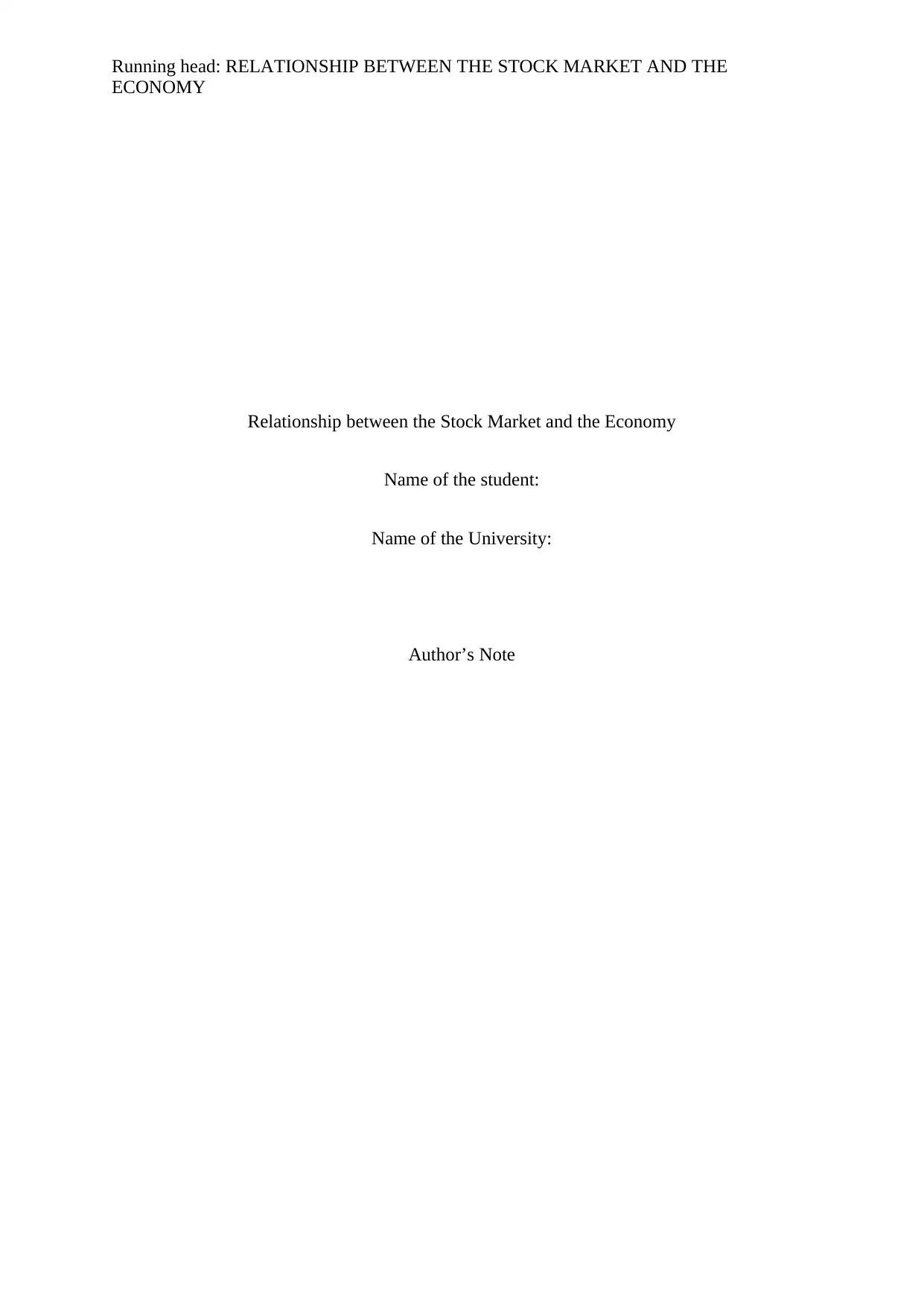
Running head: RELATIONSHIP BETWEEN THE STOCK MARKET AND THE
ECONOMY
Relationship between the Stock Market and the Economy
Name of the student:
Name of the University:
Author’s Note
ECONOMY
Relationship between the Stock Market and the Economy
Name of the student:
Name of the University:
Author’s Note
Paraphrase This Document
Need a fresh take? Get an instant paraphrase of this document with our AI Paraphraser
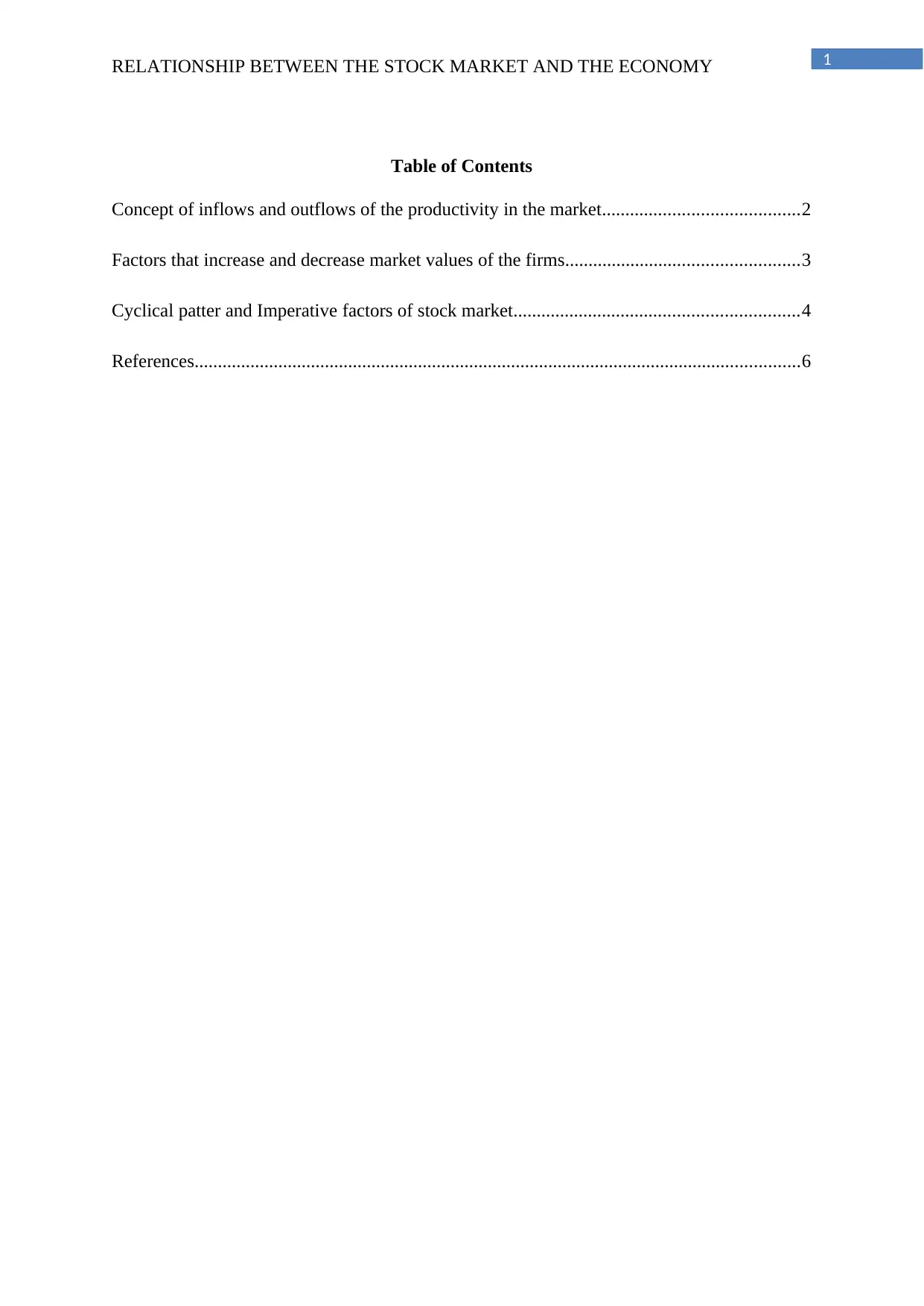
1RELATIONSHIP BETWEEN THE STOCK MARKET AND THE ECONOMY
Table of Contents
Concept of inflows and outflows of the productivity in the market..........................................2
Factors that increase and decrease market values of the firms..................................................3
Cyclical patter and Imperative factors of stock market.............................................................4
References..................................................................................................................................6
Table of Contents
Concept of inflows and outflows of the productivity in the market..........................................2
Factors that increase and decrease market values of the firms..................................................3
Cyclical patter and Imperative factors of stock market.............................................................4
References..................................................................................................................................6
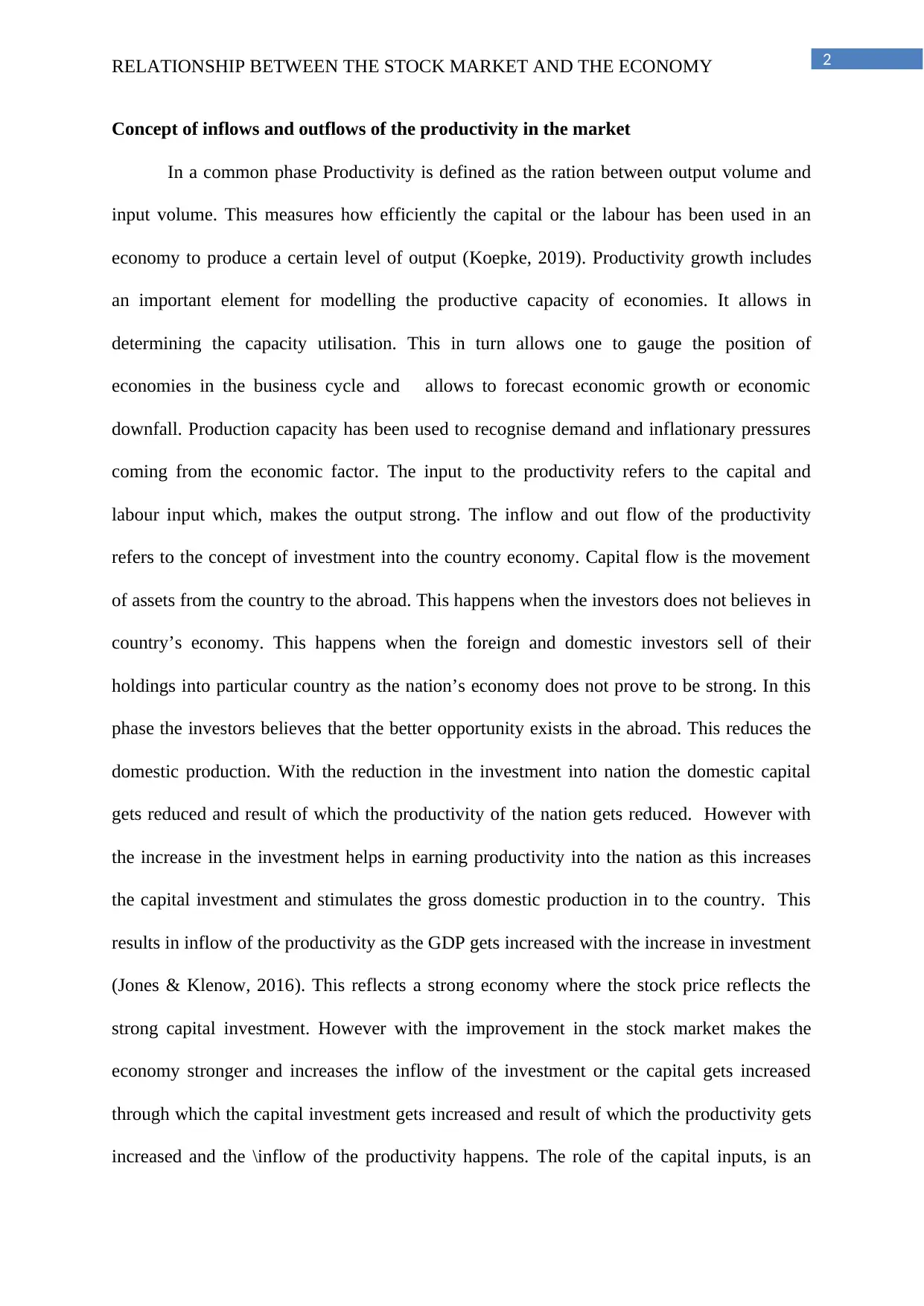
2RELATIONSHIP BETWEEN THE STOCK MARKET AND THE ECONOMY
Concept of inflows and outflows of the productivity in the market
In a common phase Productivity is defined as the ration between output volume and
input volume. This measures how efficiently the capital or the labour has been used in an
economy to produce a certain level of output (Koepke, 2019). Productivity growth includes
an important element for modelling the productive capacity of economies. It allows in
determining the capacity utilisation. This in turn allows one to gauge the position of
economies in the business cycle and allows to forecast economic growth or economic
downfall. Production capacity has been used to recognise demand and inflationary pressures
coming from the economic factor. The input to the productivity refers to the capital and
labour input which, makes the output strong. The inflow and out flow of the productivity
refers to the concept of investment into the country economy. Capital flow is the movement
of assets from the country to the abroad. This happens when the investors does not believes in
country’s economy. This happens when the foreign and domestic investors sell of their
holdings into particular country as the nation’s economy does not prove to be strong. In this
phase the investors believes that the better opportunity exists in the abroad. This reduces the
domestic production. With the reduction in the investment into nation the domestic capital
gets reduced and result of which the productivity of the nation gets reduced. However with
the increase in the investment helps in earning productivity into the nation as this increases
the capital investment and stimulates the gross domestic production in to the country. This
results in inflow of the productivity as the GDP gets increased with the increase in investment
(Jones & Klenow, 2016). This reflects a strong economy where the stock price reflects the
strong capital investment. However with the improvement in the stock market makes the
economy stronger and increases the inflow of the investment or the capital gets increased
through which the capital investment gets increased and result of which the productivity gets
increased and the \inflow of the productivity happens. The role of the capital inputs, is an
Concept of inflows and outflows of the productivity in the market
In a common phase Productivity is defined as the ration between output volume and
input volume. This measures how efficiently the capital or the labour has been used in an
economy to produce a certain level of output (Koepke, 2019). Productivity growth includes
an important element for modelling the productive capacity of economies. It allows in
determining the capacity utilisation. This in turn allows one to gauge the position of
economies in the business cycle and allows to forecast economic growth or economic
downfall. Production capacity has been used to recognise demand and inflationary pressures
coming from the economic factor. The input to the productivity refers to the capital and
labour input which, makes the output strong. The inflow and out flow of the productivity
refers to the concept of investment into the country economy. Capital flow is the movement
of assets from the country to the abroad. This happens when the investors does not believes in
country’s economy. This happens when the foreign and domestic investors sell of their
holdings into particular country as the nation’s economy does not prove to be strong. In this
phase the investors believes that the better opportunity exists in the abroad. This reduces the
domestic production. With the reduction in the investment into nation the domestic capital
gets reduced and result of which the productivity of the nation gets reduced. However with
the increase in the investment helps in earning productivity into the nation as this increases
the capital investment and stimulates the gross domestic production in to the country. This
results in inflow of the productivity as the GDP gets increased with the increase in investment
(Jones & Klenow, 2016). This reflects a strong economy where the stock price reflects the
strong capital investment. However with the improvement in the stock market makes the
economy stronger and increases the inflow of the investment or the capital gets increased
through which the capital investment gets increased and result of which the productivity gets
increased and the \inflow of the productivity happens. The role of the capital inputs, is an
⊘ This is a preview!⊘
Do you want full access?
Subscribe today to unlock all pages.

Trusted by 1+ million students worldwide
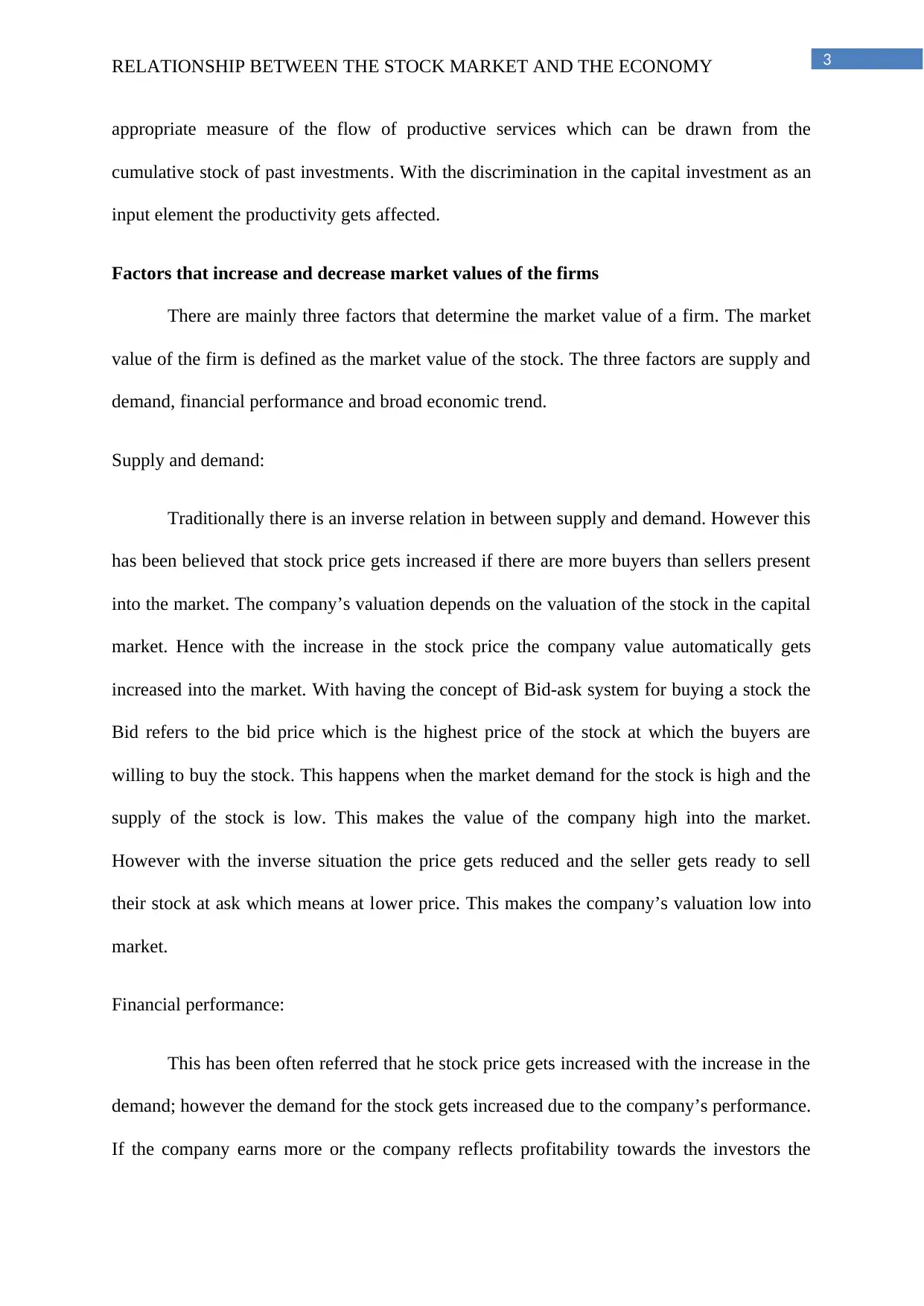
3RELATIONSHIP BETWEEN THE STOCK MARKET AND THE ECONOMY
appropriate measure of the flow of productive services which can be drawn from the
cumulative stock of past investments. With the discrimination in the capital investment as an
input element the productivity gets affected.
Factors that increase and decrease market values of the firms
There are mainly three factors that determine the market value of a firm. The market
value of the firm is defined as the market value of the stock. The three factors are supply and
demand, financial performance and broad economic trend.
Supply and demand:
Traditionally there is an inverse relation in between supply and demand. However this
has been believed that stock price gets increased if there are more buyers than sellers present
into the market. The company’s valuation depends on the valuation of the stock in the capital
market. Hence with the increase in the stock price the company value automatically gets
increased into the market. With having the concept of Bid-ask system for buying a stock the
Bid refers to the bid price which is the highest price of the stock at which the buyers are
willing to buy the stock. This happens when the market demand for the stock is high and the
supply of the stock is low. This makes the value of the company high into the market.
However with the inverse situation the price gets reduced and the seller gets ready to sell
their stock at ask which means at lower price. This makes the company’s valuation low into
market.
Financial performance:
This has been often referred that he stock price gets increased with the increase in the
demand; however the demand for the stock gets increased due to the company’s performance.
If the company earns more or the company reflects profitability towards the investors the
appropriate measure of the flow of productive services which can be drawn from the
cumulative stock of past investments. With the discrimination in the capital investment as an
input element the productivity gets affected.
Factors that increase and decrease market values of the firms
There are mainly three factors that determine the market value of a firm. The market
value of the firm is defined as the market value of the stock. The three factors are supply and
demand, financial performance and broad economic trend.
Supply and demand:
Traditionally there is an inverse relation in between supply and demand. However this
has been believed that stock price gets increased if there are more buyers than sellers present
into the market. The company’s valuation depends on the valuation of the stock in the capital
market. Hence with the increase in the stock price the company value automatically gets
increased into the market. With having the concept of Bid-ask system for buying a stock the
Bid refers to the bid price which is the highest price of the stock at which the buyers are
willing to buy the stock. This happens when the market demand for the stock is high and the
supply of the stock is low. This makes the value of the company high into the market.
However with the inverse situation the price gets reduced and the seller gets ready to sell
their stock at ask which means at lower price. This makes the company’s valuation low into
market.
Financial performance:
This has been often referred that he stock price gets increased with the increase in the
demand; however the demand for the stock gets increased due to the company’s performance.
If the company earns more or the company reflects profitability towards the investors the
Paraphrase This Document
Need a fresh take? Get an instant paraphrase of this document with our AI Paraphraser
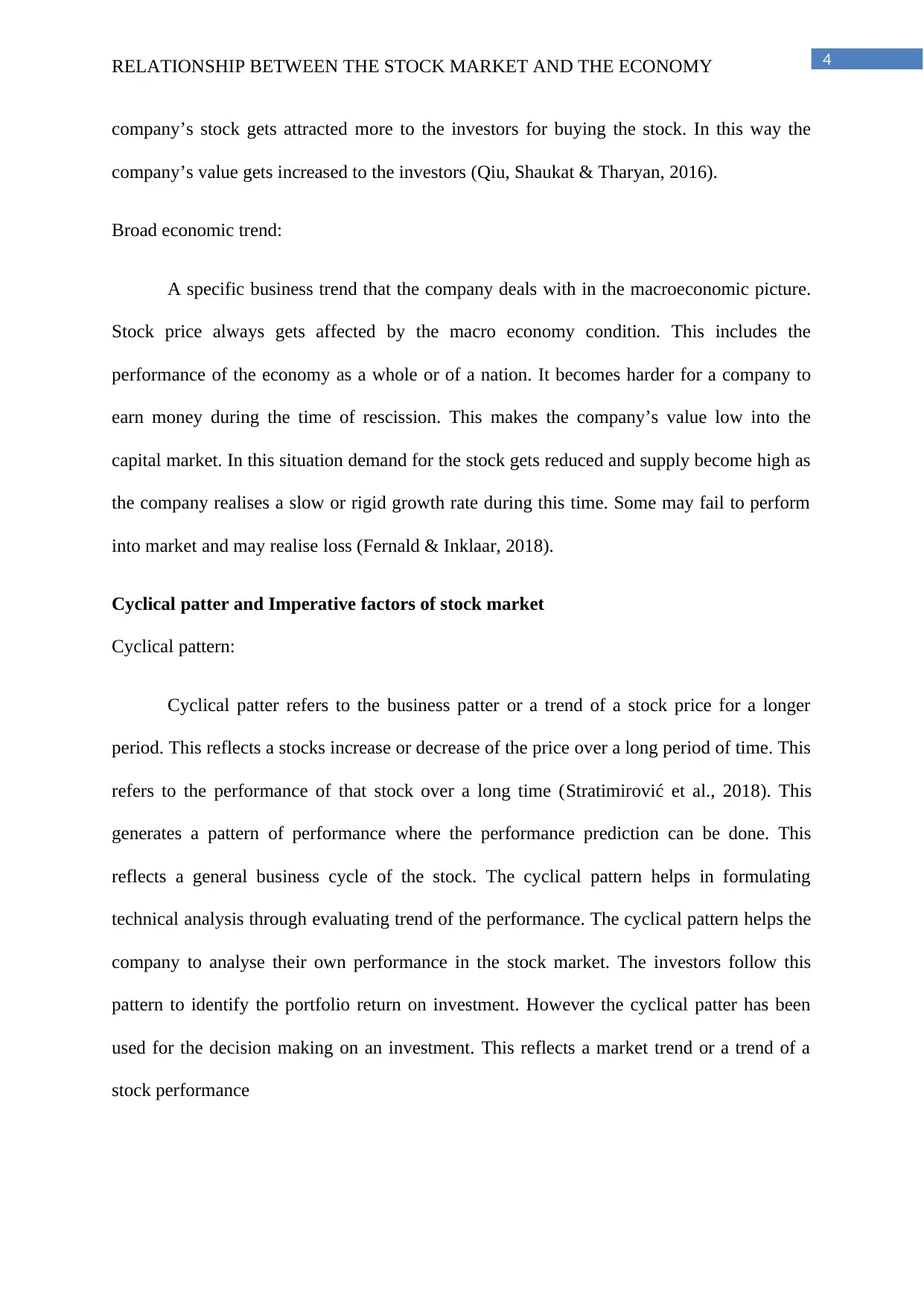
4RELATIONSHIP BETWEEN THE STOCK MARKET AND THE ECONOMY
company’s stock gets attracted more to the investors for buying the stock. In this way the
company’s value gets increased to the investors (Qiu, Shaukat & Tharyan, 2016).
Broad economic trend:
A specific business trend that the company deals with in the macroeconomic picture.
Stock price always gets affected by the macro economy condition. This includes the
performance of the economy as a whole or of a nation. It becomes harder for a company to
earn money during the time of rescission. This makes the company’s value low into the
capital market. In this situation demand for the stock gets reduced and supply become high as
the company realises a slow or rigid growth rate during this time. Some may fail to perform
into market and may realise loss (Fernald & Inklaar, 2018).
Cyclical patter and Imperative factors of stock market
Cyclical pattern:
Cyclical patter refers to the business patter or a trend of a stock price for a longer
period. This reflects a stocks increase or decrease of the price over a long period of time. This
refers to the performance of that stock over a long time (Stratimirović et al., 2018). This
generates a pattern of performance where the performance prediction can be done. This
reflects a general business cycle of the stock. The cyclical pattern helps in formulating
technical analysis through evaluating trend of the performance. The cyclical pattern helps the
company to analyse their own performance in the stock market. The investors follow this
pattern to identify the portfolio return on investment. However the cyclical patter has been
used for the decision making on an investment. This reflects a market trend or a trend of a
stock performance
company’s stock gets attracted more to the investors for buying the stock. In this way the
company’s value gets increased to the investors (Qiu, Shaukat & Tharyan, 2016).
Broad economic trend:
A specific business trend that the company deals with in the macroeconomic picture.
Stock price always gets affected by the macro economy condition. This includes the
performance of the economy as a whole or of a nation. It becomes harder for a company to
earn money during the time of rescission. This makes the company’s value low into the
capital market. In this situation demand for the stock gets reduced and supply become high as
the company realises a slow or rigid growth rate during this time. Some may fail to perform
into market and may realise loss (Fernald & Inklaar, 2018).
Cyclical patter and Imperative factors of stock market
Cyclical pattern:
Cyclical patter refers to the business patter or a trend of a stock price for a longer
period. This reflects a stocks increase or decrease of the price over a long period of time. This
refers to the performance of that stock over a long time (Stratimirović et al., 2018). This
generates a pattern of performance where the performance prediction can be done. This
reflects a general business cycle of the stock. The cyclical pattern helps in formulating
technical analysis through evaluating trend of the performance. The cyclical pattern helps the
company to analyse their own performance in the stock market. The investors follow this
pattern to identify the portfolio return on investment. However the cyclical patter has been
used for the decision making on an investment. This reflects a market trend or a trend of a
stock performance
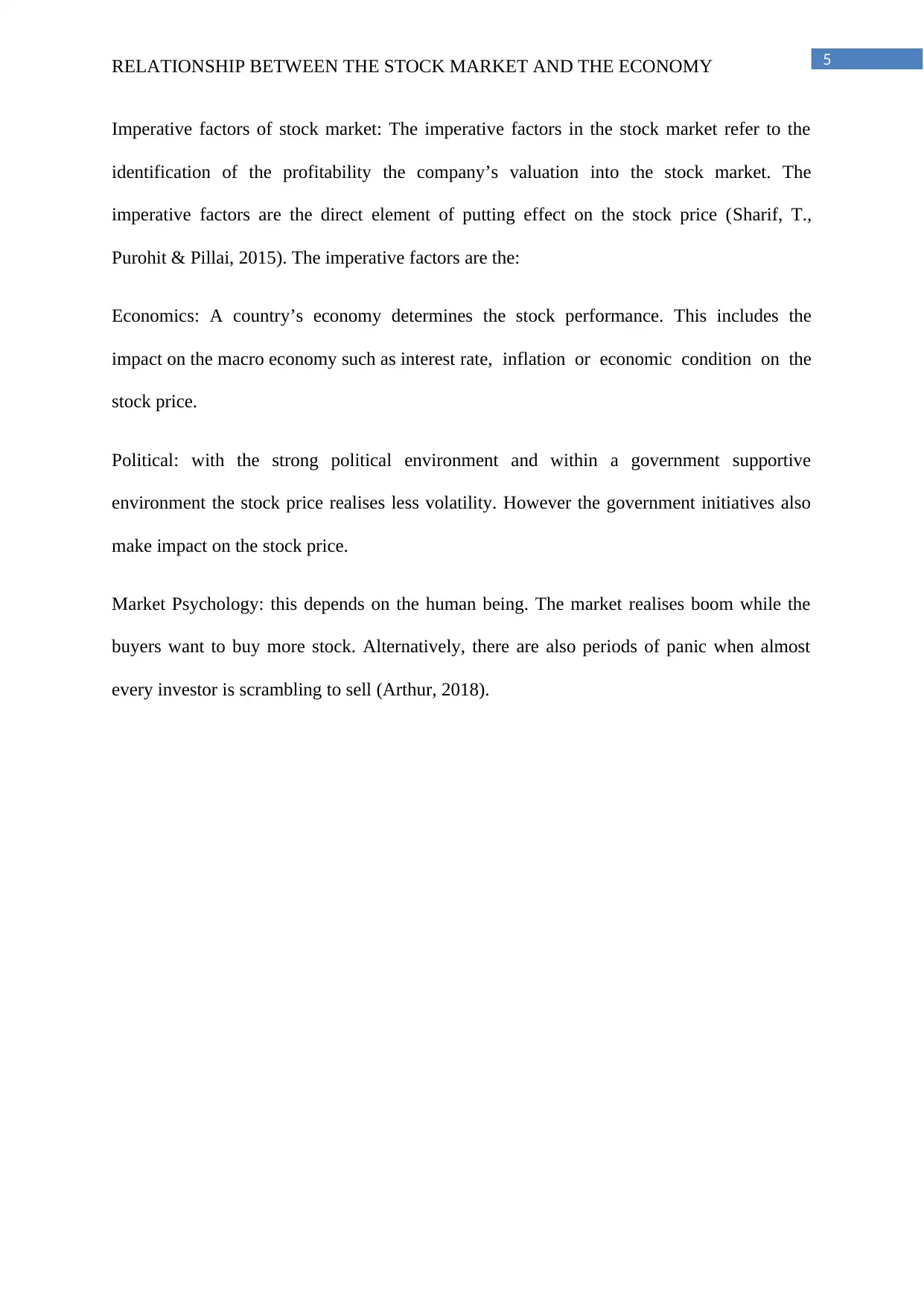
5RELATIONSHIP BETWEEN THE STOCK MARKET AND THE ECONOMY
Imperative factors of stock market: The imperative factors in the stock market refer to the
identification of the profitability the company’s valuation into the stock market. The
imperative factors are the direct element of putting effect on the stock price (Sharif, T.,
Purohit & Pillai, 2015). The imperative factors are the:
Economics: A country’s economy determines the stock performance. This includes the
impact on the macro economy such as interest rate, inflation or economic condition on the
stock price.
Political: with the strong political environment and within a government supportive
environment the stock price realises less volatility. However the government initiatives also
make impact on the stock price.
Market Psychology: this depends on the human being. The market realises boom while the
buyers want to buy more stock. Alternatively, there are also periods of panic when almost
every investor is scrambling to sell (Arthur, 2018).
Imperative factors of stock market: The imperative factors in the stock market refer to the
identification of the profitability the company’s valuation into the stock market. The
imperative factors are the direct element of putting effect on the stock price (Sharif, T.,
Purohit & Pillai, 2015). The imperative factors are the:
Economics: A country’s economy determines the stock performance. This includes the
impact on the macro economy such as interest rate, inflation or economic condition on the
stock price.
Political: with the strong political environment and within a government supportive
environment the stock price realises less volatility. However the government initiatives also
make impact on the stock price.
Market Psychology: this depends on the human being. The market realises boom while the
buyers want to buy more stock. Alternatively, there are also periods of panic when almost
every investor is scrambling to sell (Arthur, 2018).
⊘ This is a preview!⊘
Do you want full access?
Subscribe today to unlock all pages.

Trusted by 1+ million students worldwide
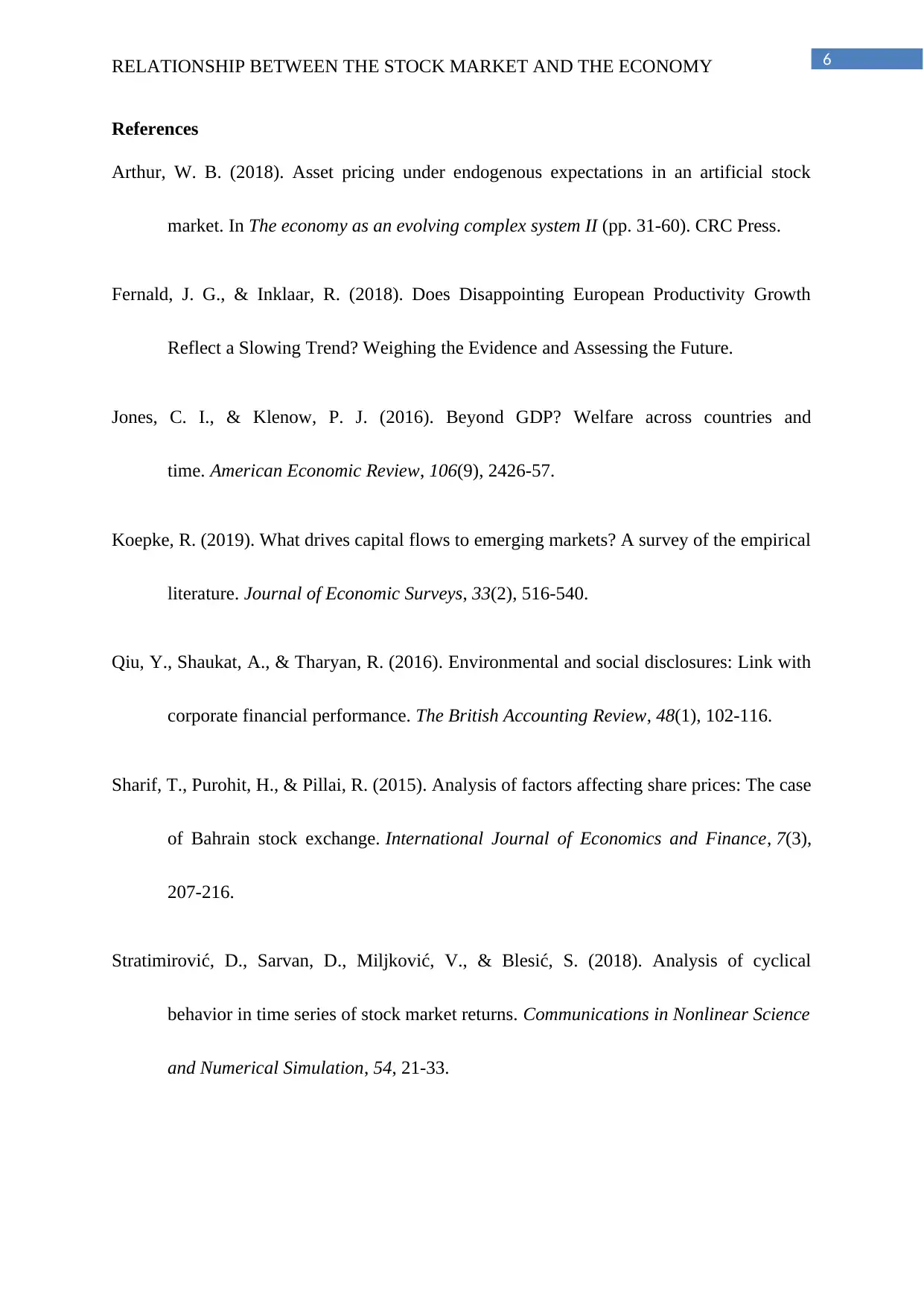
6RELATIONSHIP BETWEEN THE STOCK MARKET AND THE ECONOMY
References
Arthur, W. B. (2018). Asset pricing under endogenous expectations in an artificial stock
market. In The economy as an evolving complex system II (pp. 31-60). CRC Press.
Fernald, J. G., & Inklaar, R. (2018). Does Disappointing European Productivity Growth
Reflect a Slowing Trend? Weighing the Evidence and Assessing the Future.
Jones, C. I., & Klenow, P. J. (2016). Beyond GDP? Welfare across countries and
time. American Economic Review, 106(9), 2426-57.
Koepke, R. (2019). What drives capital flows to emerging markets? A survey of the empirical
literature. Journal of Economic Surveys, 33(2), 516-540.
Qiu, Y., Shaukat, A., & Tharyan, R. (2016). Environmental and social disclosures: Link with
corporate financial performance. The British Accounting Review, 48(1), 102-116.
Sharif, T., Purohit, H., & Pillai, R. (2015). Analysis of factors affecting share prices: The case
of Bahrain stock exchange. International Journal of Economics and Finance, 7(3),
207-216.
Stratimirović, D., Sarvan, D., Miljković, V., & Blesić, S. (2018). Analysis of cyclical
behavior in time series of stock market returns. Communications in Nonlinear Science
and Numerical Simulation, 54, 21-33.
References
Arthur, W. B. (2018). Asset pricing under endogenous expectations in an artificial stock
market. In The economy as an evolving complex system II (pp. 31-60). CRC Press.
Fernald, J. G., & Inklaar, R. (2018). Does Disappointing European Productivity Growth
Reflect a Slowing Trend? Weighing the Evidence and Assessing the Future.
Jones, C. I., & Klenow, P. J. (2016). Beyond GDP? Welfare across countries and
time. American Economic Review, 106(9), 2426-57.
Koepke, R. (2019). What drives capital flows to emerging markets? A survey of the empirical
literature. Journal of Economic Surveys, 33(2), 516-540.
Qiu, Y., Shaukat, A., & Tharyan, R. (2016). Environmental and social disclosures: Link with
corporate financial performance. The British Accounting Review, 48(1), 102-116.
Sharif, T., Purohit, H., & Pillai, R. (2015). Analysis of factors affecting share prices: The case
of Bahrain stock exchange. International Journal of Economics and Finance, 7(3),
207-216.
Stratimirović, D., Sarvan, D., Miljković, V., & Blesić, S. (2018). Analysis of cyclical
behavior in time series of stock market returns. Communications in Nonlinear Science
and Numerical Simulation, 54, 21-33.
1 out of 7
Related Documents
Your All-in-One AI-Powered Toolkit for Academic Success.
+13062052269
info@desklib.com
Available 24*7 on WhatsApp / Email
![[object Object]](/_next/static/media/star-bottom.7253800d.svg)
Unlock your academic potential
Copyright © 2020–2025 A2Z Services. All Rights Reserved. Developed and managed by ZUCOL.





